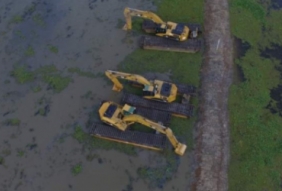
Posted on November 30, 2015
A private wetlands creation project in Plaquemines Parish, with the size and complexity of state-built coastal restoration work, expects to take advantage of a mitigation bank to bring back wetlands near the Mississippi River and make a profit at the same time.
Mitigation banks are a vehicle by which a company doing habitat restoration work earns credits that it can then sell to other companies doing projects that damage wetlands or other habitats. Companies receive credits before the project begins, once it’s finished, three years after completion and seven years after completion.
The credits received before a project begins are often used as startup funds for the project.
The Plaquemines project started about five years ago when George Howard, CEO of Restoration Systems in Raleigh, North Carolina, learned there were going to be opportunities for mitigation banks in southeast Louisiana as the U.S. Army Corps of Engineers started looking for credits following the completion of the massive New Orleans levee project.
The Corps has plans to satisfy its mitigation needs for the levee work with other projects, including one under construction, said Rene Poche, a Corps spokesman.
However, Howard said there are other Corps projects, like levee work in Plaquemines Parish, that will require credits in the future.
“There has always been a lack of marsh credits in Barataria Bay,” he said.
In this project, Great Lakes Dredge and Dock Co. provided up-front money to start the project and is operating as a business partner with Restoration Systems. Great Lakes has done a lot of dredging and marsh building work in Louisiana, and while fronting money means the company is taking on more risk, it could mean a better profit in the long term, Howard said.
“We don’t expect any profit in the early years,” he said.
Howard said selling the credits received before the project began and after it is done should cover the cost of building the project, with a profit hopefully to come on the credits received after three years and seven years.
“We have not received the first release of credits yet,” Howard said; even so, dredging on the 338-acre property in Jesuit Bend has already begun. Through the project, about 234 acres of the former agricultural property will be restored from open water to fresh marsh, 12.8 acres of marsh will be repaired and 42 acres of cypress swamp will be preserved.
Dredging from the Mississippi River started the second week of October and involves pumping the sediment 5 miles under roads and railroads and over levees to get to the marsh-creation site. In all, the project is expected to pull 1.3 million cubic yards of sediment out of the river.
The work is due to be done in January or early February, at a cost of about $250,000 a day.
At one point in its history, the property was surrounded by levees and water was pumped out in order for it to be used for agricultural purposes, but that caused the organic soil to decompose faster, said Andy Nyman, a wetlands consultant on the project. When the levees eventually breached, large parts of the area became open water, which now averages about 3 feet in depth across the property.
“They asked me to help them try to see how to make sure it was successful,” Nyman said. “That comes down to elevation in this case.”
A benefit of the location is that it is so close to the Mississippi River that the foundation is unusually solid, with heavier sediment left after years of river overflow that built the area.
“It has a very hard bottom, which makes settlement less of a concern,” Howard said.
There have been other mitigation bank projects done in the state, but Howard said this one is unique because the source of the material is the river itself.
Other such banks have dredged material from the area near the mitigation project. That method, seen by some as robbing Peter to pay Paul because it just moves dirt around, has gone out of favor with regulatory agencies.
It’s not a new technique, and the state has done something similar with marsh creation projects in Plaquemines Parish such as Bayou Dupont, Lake Hermitage and areas built through long-distance sediment pipelines.
“I’d like to think we’re doing a state-scale project,” Howard said.
For a private entity to do this kind of project, there was some skepticism about whether the project would move forward.
“We’ve had some fun going around the state, seeing old friends and saying, ‘Yes, it’s going to happen,’ ” he said.
Follow Amy Wold on Twitter, @awold10.





